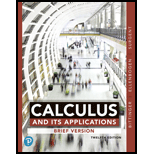
Concept explainers
Classify each statement as either true or false.
Riemann sums are a way of approximating the area under a curve by using rectangles.
Whether the statement “Riemann sums area way of approximating the area under the curve by using the rectangles” is true or false.
Answer to Problem 1RE
Solution: The statement Riemann sums area way of approximating the area und the curve by using the rectangles is True.
Explanation of Solution
Given Information:
The statement provided in the question is Riemann sums area way of approximating the area und the curve by using the rectangles.
In Riemann summation process, the area under the curve is been divided in many rectangles, and then the area of each rectangle is added in order to calculate the total area under the curve.
Hence, the statement Riemann sums area way of approximating the area und the curve by using the rectangles is True.
Want to see more full solutions like this?
Chapter 4 Solutions
CALCULUS+ITS APPLICATIONS
Additional Math Textbook Solutions
A First Course in Probability (10th Edition)
Precalculus
Elementary Statistics (13th Edition)
College Algebra with Modeling & Visualization (5th Edition)
Elementary Statistics: Picturing the World (7th Edition)
Basic Business Statistics, Student Value Edition
- Explain the relationship between 12.3.6, (case A of 12.3.6) and 12.3.7arrow_forwardExplain the key points and reasons for the establishment of 12.3.2(integral Test)arrow_forwardUse 12.4.2 to determine whether the infinite series on the right side of equation 12.6.5, 12.6.6 and 12.6.7 converges for every real number x.arrow_forward
- use Corollary 12.6.2 and 12.6.3 to derive 12.6.4,12.6.5, 12.6.6 and 12.6.7arrow_forwardExplain the focus and reasons for establishment of 12.5.1(lim(n->infinite) and sigma of k=0 to n)arrow_forwardExplain the focus and reasons for establishment of 12.5.3 about alternating series. and explain the reason why (sigma k=1 to infinite)(-1)k+1/k = 1/1 - 1/2 + 1/3 - 1/4 + .... converges.arrow_forward
- Explain the key points and reasons for the establishment of 12.3.2(integral Test)arrow_forwardUse identity (1+x+x2+...+xn)*(1-x)=1-xn+1 to derive the result of 12.2.2. Please notice that identity doesn't work when x=1.arrow_forwardExplain the key points and reasons for the establishment of 11.3.2(integral Test)arrow_forward
- Algebra & Trigonometry with Analytic GeometryAlgebraISBN:9781133382119Author:SwokowskiPublisher:Cengage

 Mathematics For Machine TechnologyAdvanced MathISBN:9781337798310Author:Peterson, John.Publisher:Cengage Learning,
Mathematics For Machine TechnologyAdvanced MathISBN:9781337798310Author:Peterson, John.Publisher:Cengage Learning,


